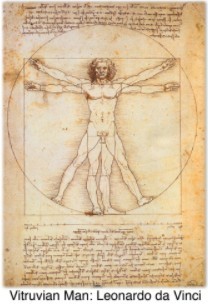Why Create?
Today we take for granted the idea that creativity is a human
attribute. The question “Why Create?” is predicated on the assumption
that we have the option do so. But that assumption has only been around
for about 500 years. Prior to the Renaissance, the notion of individual
creativity didn’t exist, because the concept of individuality as we now
understand it didn’t exist. Paintings, for example, remained unsigned,
and painters, anonymous, because the individual was considered
unimportant. All creative power was vested Above.
On a larger scale, great Gothic cathedrals like Chartres were the
products of thousands of people toiling anonymously in collaborative
efforts that continued over hundreds of years. The great cathedrals were
deliberately designed to give the person who entered them an
overwhelming feeling of insignificance in the presence of an omnipotent
and omniscient Deity.
Individualism Recognized as a Value

A
remarkable shift occurred during the Renaissance, when the power and
potency of the individual began once again to be celebrated, as they had
been in Greek and Roman times. In 1486, the Renaissance scholar and
philosopher Pico della Mirandola offered his Oration on the Dignity of Man,
heralding the shift from the medieval worldview, which disempowered the
individual, to the revolutionary notion that we humans, unlike other
creatures, have been placed at the very center of the universe, and
blessed with powers of free will and creativity that are unlimited and
virtually godlike.
Pico articulated the revolutionary notion that creativity is part of
our expression of free will, part of what makes us uniquely human. He
celebrates the notion that we create because we can. Leonardo da Vinci’s
Vitruvian Man (a.k.a. “Canon of Proportion”) and Michelangelo’s “David”
are the best-known symbols of this humanistic rebirth of individual
creativity. But there is one man, Filippo Brunelleschi, who was the
pre-eminent force in the emergence of the new human-centered worldview,
for he both literally and figuratively created a new human-centered
perspective. Just as the Gothic cathedrals had communicated a message
about humanity’s place in the universe, Brunelleschi’s architecture sent
an equally profound but very different message, as best exemplified by
his dome for the Florence cathedral.
Standing beneath Brunelleschi’s heavenly dome, one feels oneself to
be at the center of Creation. One does not feel overpowered and
belittled, but exalted and uplifted in this sacred space. Humankind’s
centrality and importance are also affirmed in Brunelleschi’s invention
of three-dimensional perspective in art; which he taught to Massaccio,
who produced the first Renaissance painting and to Donatello who created
the first Renaissance sculpture. And Brunelleschi exemplified the new
ethos in his own life by registering the world’s first patent for an
invention (his remarkable ox-hoist) – patents being the legal and
economic expression of the value placed on the individual’s intellectual
capital.
Emergence of the Renaissance Man
Although Brunelleschi is the seminal
force, Leonardo da Vinci reigns as the supreme expression of the
“Renaissance Man” or “Uomo Universale” (Universal Man). DaVinci serves
as a global archetype of individual creative possibility. In 1994 Bill
Gates paid $30.8 million dollars for 18 pages of DaVinci’s notebooks.
Why did Gates pay so much? Because he can! And, it’s easy to imagine
that Gates recognizes that his own legacy resides in his role in the
transformation from the Industrial Age to the Information Age; and that
he wanted to associate himself and his brand with the works of a man who
embodies the spirit of the dawn of that earlier new age.
The Renaissance, with its brilliant
artists and architects, sculptors and scholars, taught us anew that
creativity is our birthright, a gateway to our highest expression, the
secret of individuation and personal fulfillment, and the secret of the
art of living. Creativity may also be a means to earning a good living,
as quite a number of artists discovered during the Renaissance. Before
we explore the loftier motivations for creating let’s examine the
relationship between creativity and profit.
The feudal system of the Middle Ages
collapsed because, among other things, of the invention of the
long-range cannon (built by a Hungarian engineer named Urban), which
could blast through the walls of the feudal fortress. As fortress walls
crumbled the printing press, magnetic compass, mechanical clock,
microscope and telescope expanded European horizons exponentially. The
technological breakthroughs that drove the transformation of the Middle
Ages into the Renaissance were all made possible by the funding that
became available as innovative accounting and banking systems evolved.
Brunelleschi, Leonardo, Michelangelo, Raphael and all their fellow
geniuses wouldn’t have created much of anything without the Renaissance
equivalent of corporate sponsorship. If the Sforza, Medici and a
succession of Popes hadn’t provided the capital, the Florence cathedral
would’ve remained open to the elements and there would have been no
“Last Supper,” “David” or “School of Athens.” As Professor Lisa Jardine
author of Worldly Goods: A New History of the Renaissance emphasizes,
“…those impulses which today we
disparage as ‘consumerism’ … occupy a respectable place in the
characterization of the new Renaissance mind… A competitive urge to
acquire was a precondition for the growth in production of lavishly
expensive works of art. A painter’s reputation rested on his ability to
arouse commercial interest in his works of art, not on some intrinsic
criteria of intellectual worth.”
Creativity as Vocation
Those of us who “arouse commercial
interest” through our creative endeavor — writers, photographers,
creative directors, web designers, graphic artists, composers, painters
and performers – are part of a great heritage of creating art for cash.
As literary legend Dr. Samuel Johnson put it: “No man but a blockhead
ever wrote, except for money.”
Capitalism provides the most energy and
opportunity for creative expression. And the United States of America —
founded on the remarkable idea that we are all created equal and have an
inalienable right to “life, liberty and the pursuit of happiness” — is
the greatest capitalist entity in history thus far. Our nation’s
youthful optimism, diversity and emphasis on freedom and equality
fosters an environment where creativity and innovation are more the
cultural norm than anywhere else. Yet, as we transition out of the
Industrial Age, and face unprecedented environmental, social and global
challenges, the ability to think creatively becomes more urgent and
important.
Historian of science George Sarton
writes: “Since the growth of knowledge is the core of progress, the
history of science ought to be the core of general history. Yet the main
problems of life cannot be solved by men of science alone, or by
artists and humanists: we need the cooperation of them all. “Sarton
concludes that Leonardo’s “outstanding merit” is in his demonstration
that “the pursuit of beauty and the pursuit of truth are not
incompatible.”
For Leonardo, creativity was a function
of the marriage of art and science. He emphasized, for example, that the
ability of the artist to express the beauty of the human form is
predicated on a study of the science of anatomy. But Leonardo’s science
was also based on his art.
Imagination and Creative Thinking Lead to Invention
Leonardo urged his students to awaken the
generative power of imagination in an unprecedented way. Offering “a
new and speculative idea, which although it may seem trivial and almost
laughable, is none the less of great value in quickening the spirit of
invention.” He urged students to contemplate abstract forms – patterns
of smoke, clouds, and swirls of mud – and to allow the imagination to
run freely to discover in these mundane forms “the likeness of divine
landscapes … and an infinity of things.” The Maestro then counsels that
the ideas generated in this flight of the imagination “may then be
reduced to their complete and proper forms.”
In the thousand years before DaVinci in
Europe there was very little encouragement to “quicken the spirit of
invention” by seeking “divine landscapes” or searching for “an infinity
of things.” Before Leonardo the concept of “creativity” as a human
function and an intellectual discipline didn’t exist. Inspired by
Brunelleschi and Alberti, Leonardo effectively invented the modern
discipline of “creative thinking.”
Just as Leonardo helped to invent the art
of creative thinking he also points us toward a compelling reason to
create: to know ourselves and the world around us – to appreciate truth
and beauty — through mirroring the creative source. In his classic work The Creators: A History of Heroes of the Imagination,
Daniel J. Boorstin addresses the mystery of the motivating forces of
creativity. He notes, “the human need to create has transcended the
powers of explanation.” Boorstin adds, “Peoples of ancient Egypt, Greece
and Rome who did not know a Creator-God, who made something from
nothing, still created works unexcelled of their kind. And peoples of
the East who saw a cosmos of cycles created works of rare beauty in all
the arts. Across the world, the urge to create needed no express reason
and conquered all obstacles.” Boorstin summarizes the prologue of his
journey through the history of Heroes of the Imagination,
by proclaiming his intention to “describe the who, when, where, and
what.” But, he concludes, “the why has never ceased to be a mystery.”
Creativity and Immortality
Of course, as Boorstin speculates, “Man’s
power to make the new was the power to outlive himself in his
creations.” In other words, for some, the motivation to create is to
achieve immortality. And, of course, it isn’t necessary to posit or
believe in God in order to create, but as Vincent van Gogh expressed it,
“I can do very well without God in both my life and my painting but I
cannot…do without something which is greater than I, which is my life,
the power to create.”
The Chinese philosopher T’ang Hou
reflects on the nature of the power – the “something greater” referenced
by van Gogh: “Landscape painting is the essence of the shaping powers
of Nature. Thus, through the vicissitudes of yin and yang – weather,
time, and climate – the charm of inexhaustible transformation is
unfailingly visible. If you yourself do not possess that grand wavelike
vastness of mountain and valley within your heart and mind, you will be
unable to capture it with ease in your painting.”
There is a creative force in the universe
that we can all experience in our hearts and minds as a “grand wavelike
vastness.” In creative endeavors we open ourselves to discover our
harmony with “something greater” and, if we persevere, something true
and beautiful just might emerge. As Ansel Adams expresses it, “Sometimes
I do get to places just when God’s ready to have someone click the
shutter.”
So “Why Create?” There are infinite
reasons — to make visible the charm of inexhaustible transformation, to
become more susceptible to grace, to achieve immortality, to know the
mind of God, to manage change, make a living or make a life; but the
simplest is: just because we can.
The post Why Create? appeared first on Michael Gelb.



